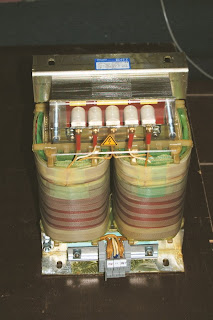My RF Amplifier project is making progress!
 The RF amplifier will work with the tetrode tube GU-84b. On the left you see the anode voltage transformer - that beast delivers 2 500 Volts at 2 Amperes in continuous service.
The RF amplifier will work with the tetrode tube GU-84b. On the left you see the anode voltage transformer - that beast delivers 2 500 Volts at 2 Amperes in continuous service.Current work is to program the controller that handles the operation of the power supply. The controller is based on the AVR microcontroller ATmega16 - a very flexible 8 bit CPU that can be programmed in C language using the GNU C compiler gcc in its avr-gcc incarnation ...
All this is done on a MacBookPro using publicly available tools on Mac OS X (10.5.2 currently).
It's pure fun - I can tell you. You should try it one day... Oh, btw, the transformer weighs a woppy 52 kg. Building the cabinet for the power supply is just about to be completed - and was not an easy task. But hey, it's just a hobby ... Now for the details -
An AVR code excerpt:
// ----------------------------------------------------
// MAIN
// ----------------------------------------------------
int main ( int nArgc, char **ppcArgv )
{
tsREPLContext sContext;
memset( &sContext, 0 , sizeof( tsREPLContext ));
vSetREPLContext( &sContext );
// Start of controller ... so boot and init!
boot();
init();
// Controller main loop
while( 1 )
{
repl();
}
// This point is never reached
return -1;
}
"Nothing special" you say? Well, maybe. Let's have a closer look:
- A "context" is used - Lispers will recognize this as the environment. The context is used to hold global state and global data. This technique allows for context switches - between different modes, like "normal operation" and "service mode", by a single function call.
- The AVR is run in interrupt mode via a timer interrupt. Every 2 ms a routine is called that reads external devices: pushbuttons, the RS232C port, the I2C bus. The values that are read from these devices are stored in the context.
- The REPL (the Read Eval Print Loop - also known from Lisp implementations) now reads those values, evaluates them (well, not really in the sense of a Lisp), and prints the values - which in effect means that results are written back to the devices: lamps, relays (via the I2C bus), digital and analog outputs.
Some more pictures:


These are the capacitor banks: 300 uF at max 5600 V. The energy stored will be around 1500 Joule.
Actual values will be: 3240 V with 1500 Joule - Nothing to be taken lightly!
THIS IS HIGH VOLTAGE !
High Voltage can kill - please be very careful when trying this at home!

The GU-84b tube in a test configuration. See also: http://www.sm5cki.se/ompower/testrig.html
I don't want to miss to point you to some very interesting places:
- Yahoo group "ham_amplifiers"
- Rich Measure's web site on RF Amplifiers
- This Japanese site is an RF Amplifier Heaven ...
Enjoy - and build one yourself - you'll have pure fun and learn a lot along the way ...
Yours truly,
frgo.

Kommentare